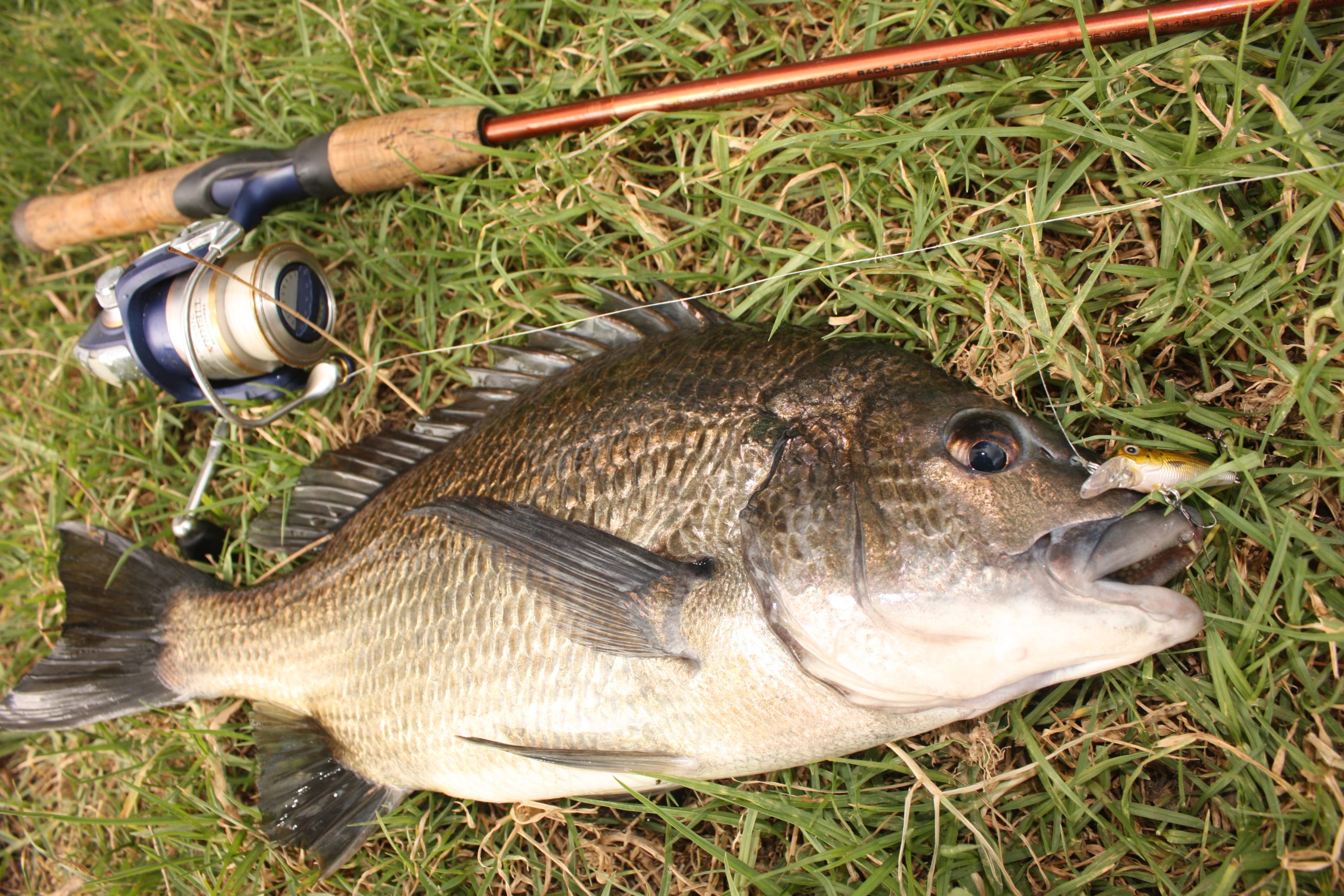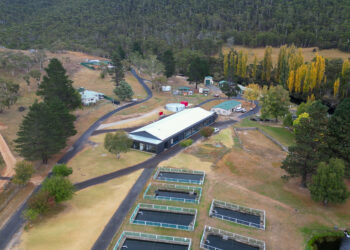You don’t need a boat to catch quality bream on hard-bodied lures. BEN CADDAYE explains.
IT makes sense to be on the water and mobile when chasing bream with lures. A boat or small water craft not only makes it easier to find bream, it also allows anglers to move quickly from location to location, following the tides, bait and concentrations of feeding fish. Sneaking up on bream and casting to them, especially around structure, can also be much easier if you’re on a carefully positioned boat or kayak.
But there’s no reason why shore-based anglers can’t get their slice of the bream luring action as well. While a lot of fishos target bream from the shore with bait, only a few throw hard-bodied or soft plastic lures from terra firma in a dedicated attempt to catch these fish.
Most land-based bream lurers I know of walk the open flats, employing longs casts with surface lures to connect to yellowfin bream cruising the shallows. But the land-based breaming can be just as good – or better – in the narrow, snaggy, tree-lined creeks and inlets in the upper reaches of many estuary systems.The good thing about these locales is you’re likely to encounter a mix of yellowfin and black bream, and the average size of fish is generally very good too.

I started chasing bream from the bank on lures out of necessity after selling my kayak in 2013. Parting with the ‘yak was a spur-of-the moment decision, one which I regretted almost immediately. I regularly used my kayak to fish a couple of bream honey holes on the NSW Far South Coast. These creeks and backwaters are too small for a boat – the only way to fish them is via paddle power or on foot. Without my ‘yak, I only had one option: walk the shoreline with a handful of lures and hope for the best. To be honest, I didn’t expect to fare that well, with most of my previous shore-based bream luring sessions amounting to very little. So I was surprised and very pleased when, over the course of an hour or so, a succession of decent black bream nailed my hard-body.
A number of follow-up trips produced more fish; in fact, my results were almost on par with the ‘yak-fishing sessions I’d enjoyed in the past.

Location
I’m convinced the key ingredient to my shore-based success were the locations I was fishing – narrow, tree-lined creeks with lots of snags and tannin-stained water. Bream are notoriously flighty fish; if you can see them, they can generally see you. Sneaking up on fish from a shore-based position can be hard, so a bit of natural cover and some colour in the water always helps.
Snags and structure help too. The black and yellowfin bream I chase are extremely structure-oriented. The presence of overhanging trees, submerged logs and rock bars along and adjacent to the shoreline makes it easy for an angler walking the bank to cast to likely bream-holding areas. A lot of the time, bream will be holding tight to these pieces of structure, so a cast that lands in the vicinity is immediately in the strike zone. It also means the bream don’t often see you until your lure’s in their mouth!
The best way to fish creeks and waterways like this on foot is to walk the shoreline, staying well back from the water’s edge (if you can) and casting parallel to the bank towards any likely looking structure. If you don’t get any hits close to the shore, you can fan-out your casts to cover more terrain, as sometimes the bream are out in open water feeding over weed or yabby beds. I nail most of my fish close to shore and near structure, but I also hook a few with “blind” casts towards open water.

Other factors
Time and tide play significant roles when luring bream from the shoreline. I experience the bulk of my success either very early or late in the day. Bream relish low light conditions and are more likely to feed closer to the shoreline during these windows of opportunity around dawn and dusk.
When shore-based, I always try to time my bream luring trips with a making tide. Bream will use a rising tide to access snags, flats and undercut banks, coming within easy casting distance in the process. The last three hours of a flood tide are particularly good, and spring (or especially high) tides can turn on some remarkable fishing.
Bream aren’t really seasonal and will hit a well-placed lure year-round. In saying that, in southern NSW at least, the warmer months, from about November through to April, produce the best catches of bream on lures. My favourite months for this style of fishing are from January to March.

Lures
Luring bream from the bank has its challenges. When I’m chasing bream from my boat, I’m more often than not casting into shallower water and slowly working my lure back into deeper water. Shore-based anglers are at a disadvantage right from outset given they’re usually doing the complete opposite. Retrieving a soft plastic or hard-bodied diver from deep water into shallow often results in snagged lures and fouled trebles. The best way to combat this is by carefully choosing your lure.
Floating or suspending hard-bodies are my favourite choice of lure for this style of fishing as you can exercise a fair degree of control over them, allowing you to manoeuvre around snags and prevent them from simply ploughing into the bottom or fouling in the rocks or weed. My go-to hard-body is the sublime little Atomic Hardz Crank 38 (Mid or Deep). It casts well and gets down into the strike zone quickly but, when paused, floats slowly to the surface, allowing you to “drive” it through snaggy terrain. There are plenty of similar small floating or suspending lures that are equally effective (see Fact Box on page 81).
Surface lures are another great choice for shore-based fishing in the shallow, snaggy creeks. Poppers and walk-the-dog-style stick baits can be dynamite when retrieved over rock bars, yabby beds and alongside drowned timber. I turn to them when the terrain is especially snaggy or when there are signs of surface feeding bream in the vicinity (such as the tell-tale “kissing” sound of a bream slurping tiny prawns or baitfish off the surface). The warmer months in particular are a great time to flick surface lures from the shore. Bream like slow retrieves featuring lots of pauses. You’ll pick up whiting, tailor and flathead as by-catch, too.
Soft plastics are a trickier proposition. I’ve had only modest success with small wrigglers and prawn imitation plastics fished on relatively light jig-heads – mainly because it’s difficult to control the sink rate. Retrieving a lure that wants to sink through snaggy terrain is a recipe for frustration. Anglers can combat this issue by using very light or hidden weight jig-heads, although this does significantly reduce casting distance. Don’t get me wrong, plastics can and do work when fished from the shore, but expect some snags in between fish.

Tackle
Light spin tackle is ideal for this form of fishing – just don’t go too light! Wrestling a decent bream from structure is challenging at the best of times; when you’re on the shoreline, often with little scope to move or alter the direction of the fight, the degree of difficulty increases. I opt for 6lb braid and 8-10lb leader as a bare minimum. A seven-foot, 2-4kg rod will provide the casting distance and leverage you need.
Conclusion
Anglers fishing for bream with lures from a boats or kayaks are nearly always going to out-fish their shore-based counterparts. But if you’re without any form of water craft, bream luring is still something you can definitely pursue from dry land. There are countless creeks and backwaters like the ones I’ve described in this article; if you can find one, you too can enjoy a bit of productive shore-based bream luring.


















